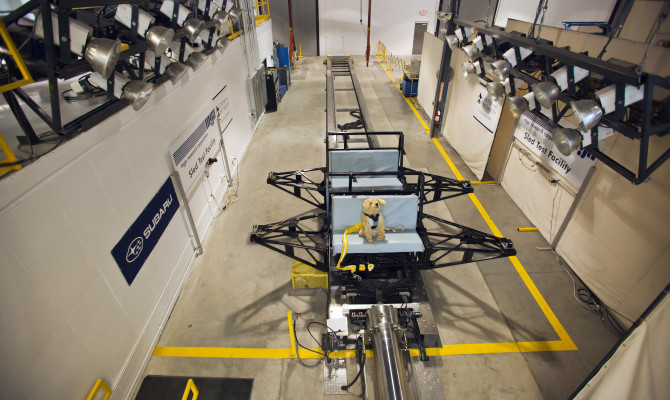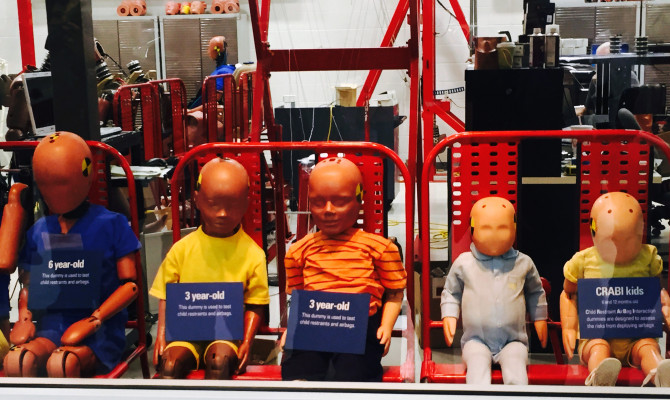“It’s quite a show to witness up close, but this is not entertainment…”
“It’s quite a show to witness up close but this is not entertainment, the various impact tests the IIHS run are designed to save lives.”
Ruckersville, Virginia.
Crash, bang, wallop… and the crash test is all over in a shorter time than it takes to say those first words aloud.
And you would have to speak loudly to be heard over the loud bang and sounds of shattering glass that echo around the cavernous building used to test the crash worthiness of dozens of vehicles annually by the Insurance Institute for Highway Safety.
It’s quite a show to witness up close but this is not entertainment, the various impact tests the IIHS run are designed to save lives. And, should you be tempted to smile an inspection of the smashed vehicle will soon wipe it from your face.
Prior to the test smash, a group of Canadian journalists spent a couple of hours touring the facility, eyeing many mangled wrecks, which, reassuringly, looked less wrecked the closer we got to later models. Clearly, their designers had learned some good lessons from the kind of thudding impact we witnessed.
Yes, indeed, car safety design has come a long way in the past 50-plus years and we were reminded of that as we entered the lobby. There was displayed a frighteningly crumpled 1959 Chevy Bel Air: nobody would have walked away from that smash in one piece.
By the time we reached the viewing gantry above the test track, we were ready to witness, the ‘small overlap frontal test’, which simulates the impact of a car’s front corner colliding with another car or utility pole.
The lights began to shine brightly and we heard the rumble of the car as it launched along the 180-metre guide track. As the driver’s side of the car hit the one-metre high barrier, the dummy driving may just have noticed the speedo was hovering at 65 km/h. (Shouldn’t have taken his eyes off the road.)
All was captured on high-definition cameras from every angle and before we were released to amble over to inspect the damage, technicians armed with laptops downloaded all the crash data stored by sensors in and on the car.
On impact, the car had spun off almost three metres to the right, rotating before it came to a halt it what might have been a sidewalk in real life. Hope there was no pedestrian in its path. At the end of the day, the car manufacturer representatives would walk away with a DVD loaded with data and images to be followed by a detailed examination some weeks later.
It’s over so quickly it’s hard for the casual observer to learn much but a slow motion video made for chilling viewing as you see the $250,000 dummy driver (some cost up to $600,000) flailing while hitting the airbag. Every habitual red-light runner should be forced to take in this horror movie.
The IIHS, which began in 1959, is a U.S. non-profit organization funded by auto insurers. The goal is to reduce injuries and fatalities on (U.S. roads and) highways but its powerful research has an impact worldwide, no pun intended.
The tour was truly a revelation and demonstrated well how most of today’s cars come through rigorous impact tests with good marks and those that don’t soon get a fix. We were hosted by Subaru Canada, which has much to boast about though it was restrained in blowing its own trumpet on location.
All Subaru models have been named IIHS “Top Safety Picks” for six years running. And that’s some feat: to qualify as a 2015 Top Safety Pick, a vehicle must earn ‘good’ ratings in the moderate overlap front, side, roof strength and head restraint tests, as well as a ‘good’ or ‘acceptable’ rating in the small overlap front test.
Subaru is excited that its optional ‘Eyesight’ system has earned the top IIHS rating of Superior for front crash protection. According to Subaru Canada, the company expects the percentage of buyers opting for Eyesight to increase from the current 19 per cent to 30 per cent by the end of the 2016 model year. The Eyesight system detects obstacles and is capable of bringing a vehicle to a complete stop at speeds up to 50 km/h.
By the way, for those concerned about crash test dummy cruelty, Raul Arbelaez, vice president of operations for the IIHS, says: “Our dummies aren’t getting as hurt as much they used to. We don’t have to replace as many rib cages anymore.”
Recent Comments
- { Enjoyed your Forest of Bowland in the BMW X5M, particularly the photo of the BMW in front of the main part of Stonyhurst College where... }
- { Bantam designed the Jeep, not Willy's or Ford. The American military gave the original Bantam prototype to Willys and Ford to copy. There is plenty... }
- { All Escalades come with a 6.2-lilter V8 engine that produces 420 horsepower. A six-speed automatic is the only transmission offered and drives the rear wheels.... }
- { Alexandra is an excellent journalist. }
Popular Posts
- Journey to a ‘Sparkling’ Luxury Okanagan Resort “Four lucky readers will put a Dodge Journey’s weekend-...
- The Need For Speed: Hike Those Highway Limits More than half of those polled believe the province sho...
- Drives-U-Crazy… Erratic drivers. An early morning drive from Kelowna to Vancouver is nor...
- Readers Respond: The Pros and Cons of Increasing B.C. Speed Limits Increasing the speed limits will only increase risk to...
- Honda CR-V Review: The Compact Crossover To Get Things Done The CRV is a very stylish and aerodynamic crossover veh...








